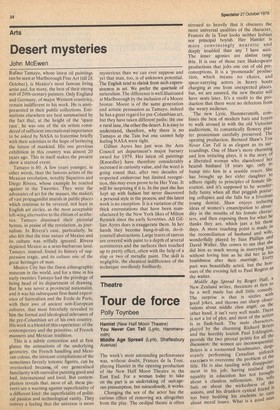Desert mysteries
John McEwen
Rufino Tamayo, whose latest oil paintings can be seen at Marlborough Fine Art (till 28 October), is Mexico's most famous living artist and, for many, the best of their strong suit of 20th-century painters. Only England and Germany, of major Western countries, remain indifferent to his work. He is unrepresented in their public collections. Esti mations elsewhere are best summarised by the fact that, at the height of the 'space race', he was one of the six artists consi dered of sufficient international importance to be asked by NASA to fraternise briefly with their scientists in the hope of bettering the future of mankind. His one previous exhibition in this country was almost 20 years ago. This in itself makes the present show a starred event.
Tamayo is 80. A few years younger, in other words, than the famous artists of the Mexican revolution, notably Siqueiros and Diego Rivera, whose example he reacted against in the Twenties. They were the advocates of art for the masses, the makers of vast propagandist murals in public places which continue to be revered, not least in English art circles, as the most acceptable left-wing alternative to the elitism of aesthetics. Tamayo dismissed their pictorial hymns, in praise of the revolution, as journalism. In Rivera's case, particularly. he also felt that the true nature of Mexico and its culture was wilfully ignored. Rivera depicted Mexico as a semi-barbarous land. Tamayo, instead, found its history of suppression tragic, and its culture one of the great heritages of man.
Mexico City has the finest ethnographic museum in the world, and for a time in his early twenties Tamayo had the privilege of being head of its department of drawing. But he was never a provincial nationalist, and it was his subsequent first-hand experience of Surrealism and the Ecole de Paris, with their awe of ancient non-European cultures, that most forcefully revealed to him the formal and ideological relevance of the pre-Columbian art of his own country. His work is a blend of this experience: of the contemporary and the primitive, of French manners and Mexican tradition.
This is a subtle concoction and at first glance the animations of the underlying geometry, the French handling and Mexican colour, the intricate compilations of the sometimes fiercely totemic figures, can be overlooked because, of our generalised familiarity with surrealist painting good and bad, international and local. But contemplation reveals that, most of all, these pictures are a warning against superficiality of a different kind: the superficiality of political passion and technological vanity. They convey a feeling that the universe is more mysterious than we can ever suppose and yet that man, too, is of unknown potential. The English tend to shrink from such expressiveness in art. We prefer the quietude of naturalism. The difference is well illustrated at Marlborough by the inclusion of a Moore bronze. Moore is of the same generation and artistic persuasion as 'Tamayo, indeed he has a great regard for pre-Columbian art, but they have taken different paths: the one a rural lane, the other the desert. It is easy to understand, therefore, why there is no Tamayo at the Tate but one cannot help feeling NASA were right.
Gillian Ayres has just won the Arts Council art department's major bursary award for 1979. Her latest oil paintings (Knoedler) have therefore considerably increased in curiosity value, and the word is going round that, after two decades of respected endeavour but limited recognition, this may even prove to be Her Year. It will be surprising if it is. In the past she has kept up with fashion but never discovered a personal style in the process, and this latest work is no exception. It is a variation of the thick encrustations that have been manufactured by the New York likes of Milton Resnick since the early Seventies. All Gillian Ayres does is exaggerate them. In her hands they become bung-it-all-in, do-ityourself abstractions. Large tracts of canvas are covered with paint to a depth of several centimetres and the surfaces then touched up to pretty effect, often with the help of a slap or two of metallic paint. The skill is negligible, the chemical indifference of the technique needlessly foolhardy.


































 Previous page
Previous page